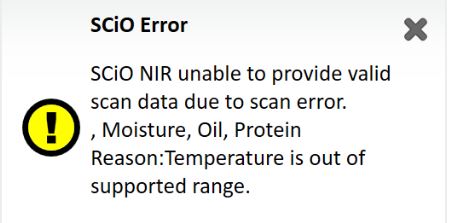H3 SCiO Sensor Maximum Operating Temperature
17 Dec 2025
Description
The maximum ambient operating temperature for the H3 GrainGage is 33°F to 122°F (1°C to 50°C). Non-operating ambient temperatures (for transport) is -40°F to 158°F (-40°C to 70°C). Recommended ambient grain temperatures may vary slightly from crop to crop, however, most are within 33°F to 120°F (1°C to 49°C). A more detail list can be found on the H3 GrainGage Data Sheet.
There are, however, times when the heat generated by the engine of the machine causes sensor temperatures to exceed ambient air temperature. When the SCIO NIR sensor reaches temperatures exceeding 70°C, it will stop sending data and Mirus will display a toast notification message indicating the sensor scan failed because of the temperature being outside the supported range.
To verify that high temperatures are what is causing the sensor failure, while Mirus is still connected to the H3 GrainGage, open Diagnostics>>Sensor Info and verify "SCIO Temperature." If you are no longer on the machine, the SCIO NIR sensor temperature is recorded in the backup log file for each plot harvested. By default, the backup log files are located at:C:\HarvestMaster\Mirus\Backups. These files are saved in a comma seperated variable (.CSV) format and can be viewed with Microsoft Excel.
Fix
- Harvest during a cooler part of the day.
- If this is not an option, outlined below are a couple suggestions to reduce the temperature of the sensor:
- Use a heat barrior between the engine of the machine and the H3 GrianGage.
- If GrainGage is protected from the wind by a seperate door or enclosure, remove doors to the GrainGage to allow for more air circulation around SCIO NIR sensor. If the GrainGage is exposed to the wind, we do not recommend removing the GrainGage doors because wind can negatively affect your weight data.
NOTE: We do not recommend using a fan to circulate air around the GrainGage because the air movement can negatively affect the weight data.
If the problem persists, contact the HarvestMaster Field Service Engineers. For contact information, see Contact a HarvestMaster Field Service Engineer.
- Phone Number: 435-753-1881
- Email: hmtechsupport@junipersys.com
- Address: 1132 W 1700 N, Logan, UT 84321


